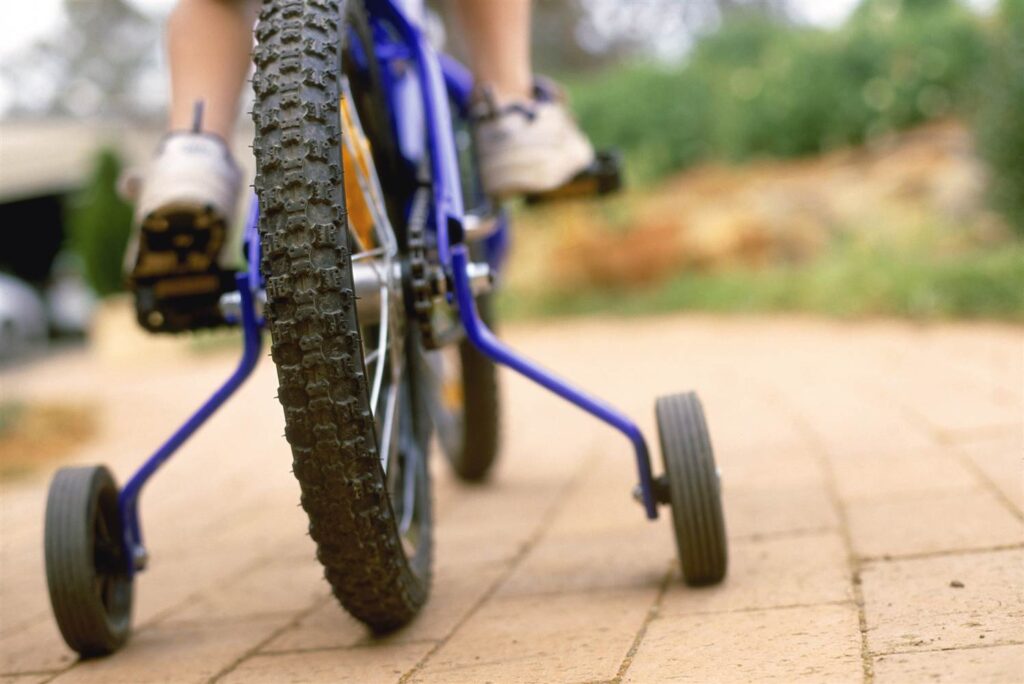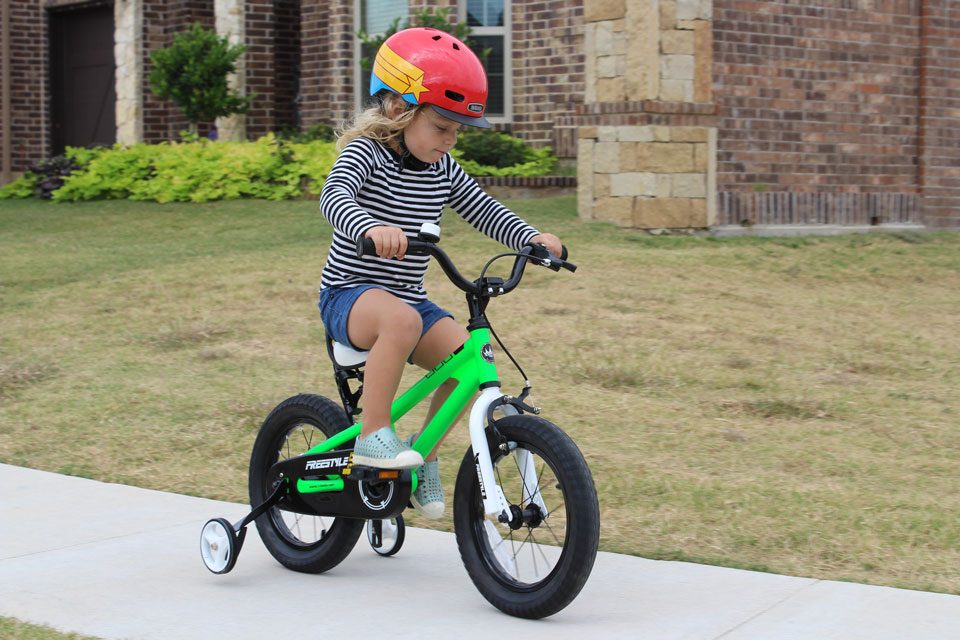Welcome to the Topic “Training Wheels: Everything You Need To Know”
In hushed accents, parents frequently ask me questions regarding the use of training wheels. This is due to the fact that they are aware that I am a strong advocate of bypassing the use of training wheels in favor of making a seamless transition from a balancing bike to a pedal bike (more on that later).
Having said that, I most certainly do not pass judgment on parents who choose to provide their children with training wheels. In point of fact, even my son used a bicycle equipped with training wheels for a short period of time before he mastered pedaling.
Here are some of the most often-asked questions I get about training wheels.
Do training wheels work?
Training wheels allow children to maintain their balance and begin pedaling a bicycle at a younger age. If you want your child to be able to ride a bike with your assistance, then the answer is yes, they work.
However, if you want your child to learn how to ride a bike, the answer is no; they do not work since they do not truly teach children how to ride a bike. If this is your aim, you should look elsewhere. As soon as they are removed, the serious part of the training may begin! It’s not easy to wean a youngster off of their car seat, what with having to do things like run beside them while hanging onto the seat and give them repeated pep speeches after crashes.
Why are training wheels bad?
It is NOT a bad idea to use training wheels. I learned how to ride a bicycle with training wheels, and it’s likely that you did as well. It’s likely that the majority of competitive cyclists began to ride with training wheels, and it didn’t hurt them in the least!
The fact that learning to ride a bicycle is simpler when training wheels are not used is one of the primary reasons they are no longer widely used and one of the primary reasons I do not suggest them to parents.

Parents quickly learned, after the introduction of balancing bikes, that the process of teaching their children to ride a bike was significantly simplified if they taught their children first how to maintain their balance and then how to pedal. It is usual for a child to begin riding a balancing bike at the age of 18 months and to be pedaling without the assistance of training wheels by the time they are 2.5 or 3 years old. There are no tears, there are no wrecks, and there is none of that awful process that you probably remember going through when you were a child.
Finally, you should consider not purchasing training wheels for your child’s bicycle because several of the leading manufacturers of children’s bicycles, such as Woom and Prevelo, are developing bikes that do not have such accessories. If for no other reason, you will almost certainly be required to forego purchasing training wheels for your child’s bike if you want it to be of a good enough quality.
Are balance bikes better than training wheels?
Yes! Those as young as 18 months old can learn to ride a bike independently with the help of balancing bikes, which also teaches children how to balance themselves. Balance bikes are nimble and quick, allowing children of any age to ride them up and over obstacles such as jumps, curbs, and hills, as well as traverse a variety of terrains.
However, in order for children to ride bicycles that have training wheels, they need to be older and taller (usually around 3 or 4 years old), and they can only ride on level terrain. Children who have mastered the use of a balancing bike do not require the use of training wheels in order to ride a pedal bike; rather, they can often just hop on the pedal cycle and start riding without any difficulty within a few minutes.
At what age?
They are offered on bicycles of varying sizes, making them suitable for children of a range of ages and sizes.
It can be difficult to locate a bike that is small enough for a child of that age to ride comfortably, despite the fact that many children of that age are ready to ride a bike. In order for a youngster to properly “fit” on a bike with training wheels, they should ideally be able to touch the ground with both of their feet at the same time while seated on the bike.
On any bike?
Training wheels for bicycles are attached to the rear axle of the bike, although not all bikes are compatible with their use. The vast majority of children’s bicycles sold in big-box stores either come with or have space for them, but many of the more expensive models do not.
The back axle of the bicycle needs to be long enough to support the arm of the training wheel, in addition to an additional bolt and washer that are used to secure the training wheels in place. This is necessary in order to accommodate training wheels. These two bolts can be found on the exterior of the bike’s frame here. There is no function served by the bolts that are situated between the back tire and the interior of the frame when training wheels are attached.
Balance bike vs bicycle with training wheels?
A balance bike! In all seriousness, I’m going to propose that you begin with a balancing bike first and then move to a pedal cycle without training wheels when you’ve gotten the hang of using the balance bike. You should still get your child started on the balancing bike, even if they are older.
You might decide against purchasing a balance bike for your kid if they are very active and already have an excellent balance or if the additional cost of another bicycle is too much for you to justify. Remove the pedals from their bike temporarily and encourage them to practice scooting and gliding while riding it in their spare time. Put the pedal back on and then proceed to follow the steps outlined in this article to teach your child how to ride a bike. Once they have that mastered, move on to the next step.
How do I transition my child away from training wheels?
Don’t freak out if your youngster is already riding a bike with training wheels on it if they already know how to do it. You have not rendered them unusable indefinitely! At this moment, you can choose between a few different courses of action. My first piece of advice is to take them back to riding a balance bike until they have a solid foundation in the art of maintaining their equilibrium on two wheels.
After that, you can reintroduce them to pedaling a bike, but this time without the use of training wheels. You can make their regular bike function in the same manner as a balance bike by temporarily removing the pedals.
There are going to be some children who are not going to be interested in the idea of a balance bike because they are already wedded to their pedal cycle. You could try elevating their training wheels such that they tilt from side to side.
Having them ride their bikes with other children who don’t need to use training wheels is another thing that can be beneficial. They will rapidly feel frustrated since they are unable to go as fast as the other children and perform stunts like them. When it comes to convincing kids to ride their bikes without using training wheels, there is nothing quite like a little bit of peer pressure.
At what age should they be removed?
As quickly as is humanly possible! It is much simpler for the process overall if children learn to balance at a younger age.
Put away the diapers and the pacifier (or, at a minimum, raise them). If they do not yet have a lot of balance, you should put them on a balance bike or create your own by removing the
Are they supposed to be uneven?
It depends! If your child expresses discomfort with the fact that they are not even, you might want to consider temporarily lowering them so that they are all the same height.
However, as they become more accustomed to riding, you should gradually increase the handles once more so that your child is rocked slightly from side to side. This compels them to learn how to balance, which will make it much simpler for you to take the training wheels off and make the transition to riding without them.

How do you adjust training wheels?
As was noted before, you will need to release the nuts that are attached to the training wheels and the bicycle frame in order to raise or lower the training wheels. First, move the wheels to the position in which you believe they should be, and then retighten the nuts.
Keep an eye on your child as they ride the bicycle. Reduce the height of the training wheels to provide them with more support if they are still having problems. If they are already rocking and rolling, you can begin gradually raising the height of the training wheels to prepare them for riding without them.
WudeBike
Hebei Wude Kids Toy Co., Ltd. is your best choice for an original Chinese equipment manufacturer (OEM) bike supplier.
We exclusively undertake work for original equipment manufacturers (OEM). The prices are based on the specifications that you choose, but the quality will be tailored to operate within the restrictions of your budget.
The importance of the Hebei region to the sector of the economy that deals with bicycles are growing. You will be in a more advantageous position for any future competitions if you are able to secure the services of an experienced partner at this stage in the game.
Have any questions regarding the topic “Training Wheels: Everything You Need To Know” feel free to comment below.
Also Read: what age to buy the kid a bike in 2022
